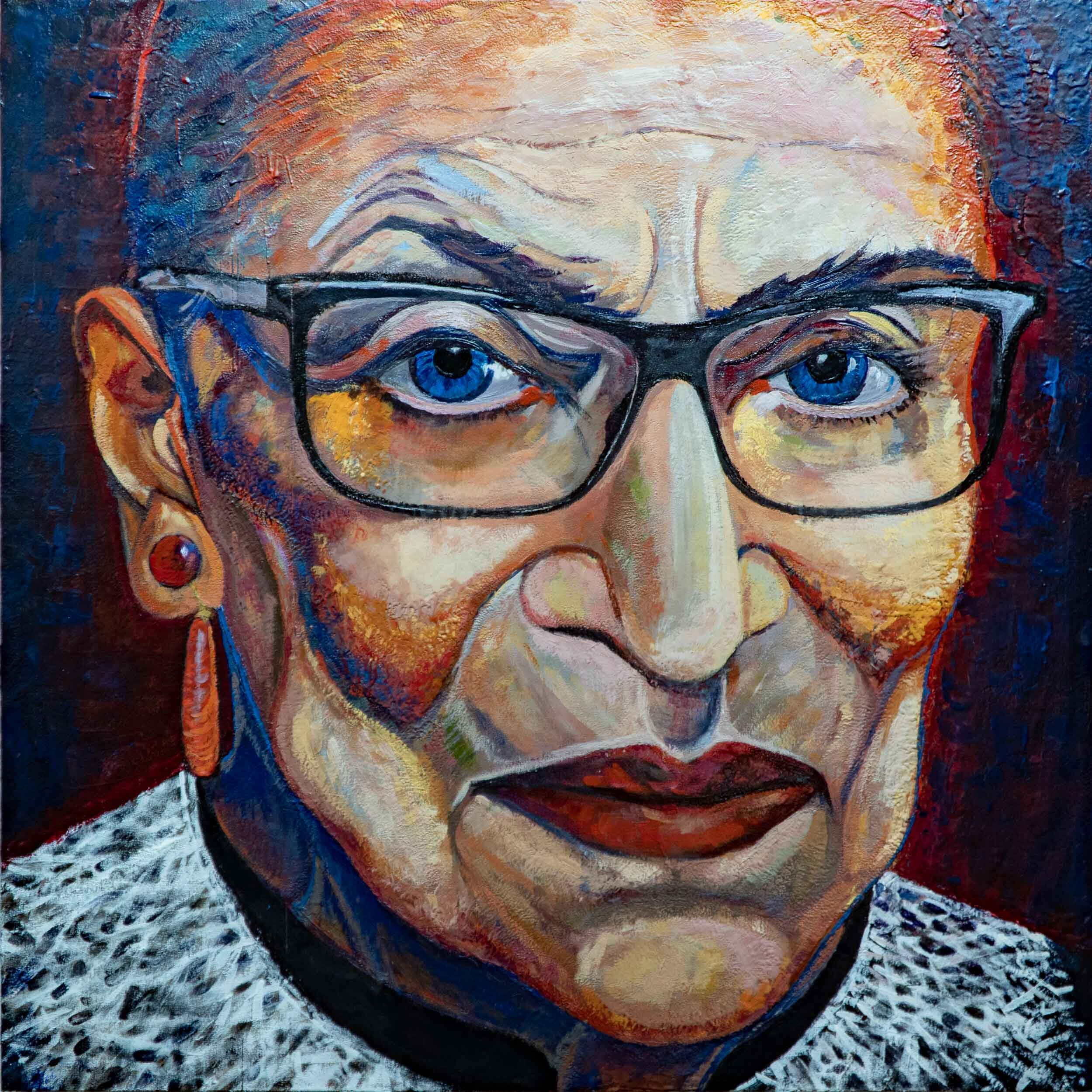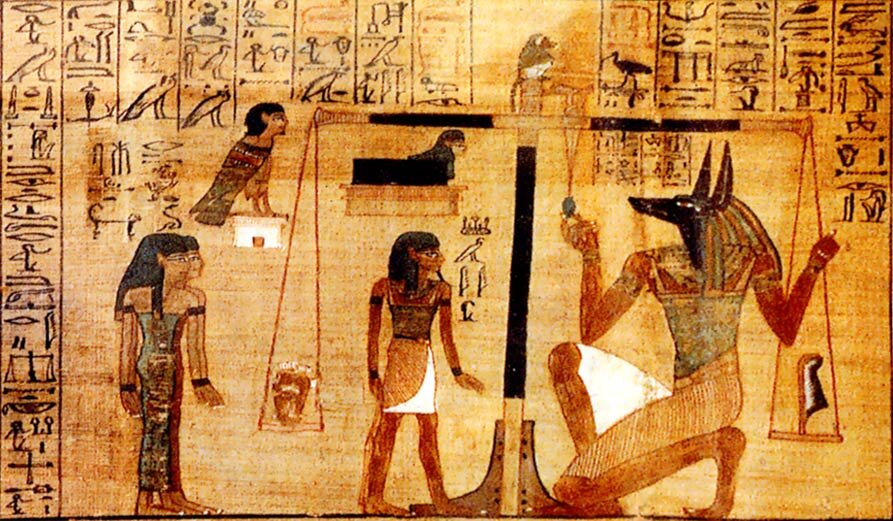Ma’at Endures
Impression of Ruth Bader Ginsburg
Ma’at is the Egyptian Goddess of law, truth and justice.
Women today are indebted to the legal work of Ruth Bader Ginsburg (Associate Justice of the Supreme Court of the United States) specifically to the Equal Credit Opportunity Act of 1974 which “prohibits discrimination on the basis of race, colour, religion, national origin, sex, marital status, or age in credit transactions.”
“Fight for the things that you care about. But do it in a way that will lead others to join you.”
Ma’at is usually depicted as a woman standing or sitting on her heels wearing the ostrich feather on her head, which is an ideogram of her name, truth or justice.
Maat wearing the feather of Truth — image: Wikimedia
Maʽat personified the ancient Egyptian concepts of truth, balance, order, harmony, law, morality, and justice. Ma’at regulated the stars and seasons, as well as the actions of mortals and the deities who had brought order from chaos at the moment of creation. Her ideological opposite was Isfet, meaning injustice, chaos, violence or to do evil.
Winged Goddess Ma’at
The "Feather of Maat" represented the concept of Maat in the Hall of Two Truths. The hearts of the dead were weighed against Ma’at’s feather. (The heart was considered part of the Egyptian soul. For this reason hearts were left in Egyptian mummies while other organs were removed.)
Ancient artisans’ village Deir el-Medina in Upper Egypt — image via Wikipedia
If the heart was found to be lighter or equal in weight to the feather of Maat, the deceased had led a virtuous life and would go on to Aaru. If the dead person’s heart were found to be heavier than the feather of Ma’at, the heart was deemed unworthy; immediately devoured by the goddess Ammit; and its owner condemned to remain in the Duat, the Egyptian underworld.
A section of the Book of the Dead showing the Weighing of the Heart in the Duat using the feather of Maat as the measure in balance
While the heart was weighed the deceased recited the 42 Truths or “Negative Confessions” as the Assessors of Maat looked on.
During the time of the Ptolemaic Kingdom (an ancient Hellenistic state based in Egypt from 305 BC to 30 BC) Greek law and Egyptian law coexisted. The Egyptian law preserved the rights of women, who were free to act independently of men and own substantial property. This influenced the restrictive conventions of the Greeks and Romans until the Romans finally took control of Egypt and imposed Roman law.
Ruth Bader Ginsburg
Ruth Bader Ginsburg (March 15, 1933 – September 18, 2020) was an Associate Justice of the Supreme Court of the United States from 1993 until her death.
Ginsburg was the first Jewish woman and the second woman to serve on the Court, after Sandra Day O'Connor. During her tenure, Ginsburg wrote notable majority opinions, including United States v. Virginia (1996), Olmstead v. L.C. (1999), Friends of the Earth, Inc. v. Laidlaw Environmental Services, Inc. (2000), and City of Sherrill v. Oneida Indian Nation of New York (2005).
Until the mid-1970s, banks and other financial institutions denied married women in the U.S. credit cards or loans in their own name, and single women also had trouble getting credit.
Women today owe a debt of gratitude to the legal work of Ruth Bader Ginsburg, specifically to the Equal Credit Opportunity Act of 1974 which “prohibits discrimination on the basis of race, colour, religion, national origin, sex, marital status, or age in credit transactions.”
Today if a person applies for a credit card or loan, his/her case can only be considered based on factors directly related to their creditworthiness.
image from Samantha Rosen’s article: How Ruth Bader Ginsburg Paved the Way for Women to Get Credit Cards
In the 1971 landmark case Reed v. Reed — Ginsburg argued that a provision of Idaho state law which said men were to be preferred to women in appointing the administrators of an estate violated the Constitution. The court agreed, finding unanimously that dissimilar treatment, “on the basis of sex,” between men and women was unconstitutional.
As the National Women’s Law Center notes, the verdict “marked the first time in history that the Court applied the Equal Protection Clause of the Fourteenth Amendment to strike down a law that discriminated against women.”
Ginsburg spent much of her legal career as an advocate for gender equality and women's rights, winning many arguments before the Supreme Court. She advocated as a volunteer attorney for the American Civil Liberties Union and was a member of its board of directors and one of its general counsel in the 1970s.
In 1980, President Jimmy Carter appointed her to the U.S. Court of Appeals for the District of Columbia Circuit, where she served until her appointment to the Supreme Court in 1993. Between O'Connor's retirement in 2006 and the appointment of Sonia Sotomayor in 2009, she was the only female justice on the Supreme Court. During that time, Ginsburg became more forceful with her dissents, notably in Ledbetter v. Goodyear Tire & Rubber Co. (2007). Ginsburg's dissenting opinion was credited with inspiring the Lilly Ledbetter Fair Pay Act which was signed into law by President Barack Obama in 2009, making it easier for employees to win pay discrimination claims.
Ginsburg received attention in American popular culture for her passionate dissents in numerous cases, widely seen as reflecting paradigmatically liberal views of the law. She was dubbed "The Notorious R.B.G.", and she later embraced the moniker. Ginsburg died at her home in Washington, D.C., on September 18, 2020, at the age of 87, from complications of metastatic pancreatic cancer.
For me, Ruth Bader Ginsburg is an embodiment of Ma’at in her quest for truth and justice.
References
- New Larousse Encyclopedia of Mythology, Hamlyn Publishing Group Ltd., New York, 1959
- Ancient Mirrors of Womanhood, Merlin Stone, Beacon Press, Boston, 1984
- When God Was A Woman, Merlin Stone, Harvest Edition, 1976
- The Civilization of the Goddess, The World of Old Europe, Marija Gimbutas, HarperCollins Publishers, 1991
- The Language of the Goddess, Marija Gimbutas, HarperRow publishers, San Francisco, 1989
- https://www.khanacademy.org/humanities/art-ameri
- https://en.wikipedia.org/wiki/Maat
- https://time.com/nextadvisor/credit-cards/ruth-bader-ginsburg-credit-card-legacy/
- https://en.wikipedia.org/wiki/Ruth_Bader_Ginsburg
- https://en.wikipedia.org/wiki/Ptolemaic_Kingdom
- https://www.worldhistoryedu.com/maat-the-egyptian-goddess-of-truth-law-order/






